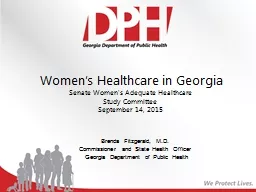PPT-Women’s Healthcare in Georgia
Author : tawny-fly | Published Date : 2018-09-16
Brenda Fitzgerald MD Commissioner and State Health Officer Georgia Department of Public Health Senate Womens Adequate Healthcare Study Committee September 14 2015
Presentation Embed Code
Download Presentation
Download Presentation The PPT/PDF document "Women’s Healthcare in Georgia" is the property of its rightful owner. Permission is granted to download and print the materials on this website for personal, non-commercial use only, and to display it on your personal computer provided you do not modify the materials and that you retain all copyright notices contained in the materials. By downloading content from our website, you accept the terms of this agreement.
Women’s Healthcare in Georgia: Transcript
Download Rules Of Document
"Women’s Healthcare in Georgia"The content belongs to its owner. You may download and print it for personal use, without modification, and keep all copyright notices. By downloading, you agree to these terms.
Related Documents














